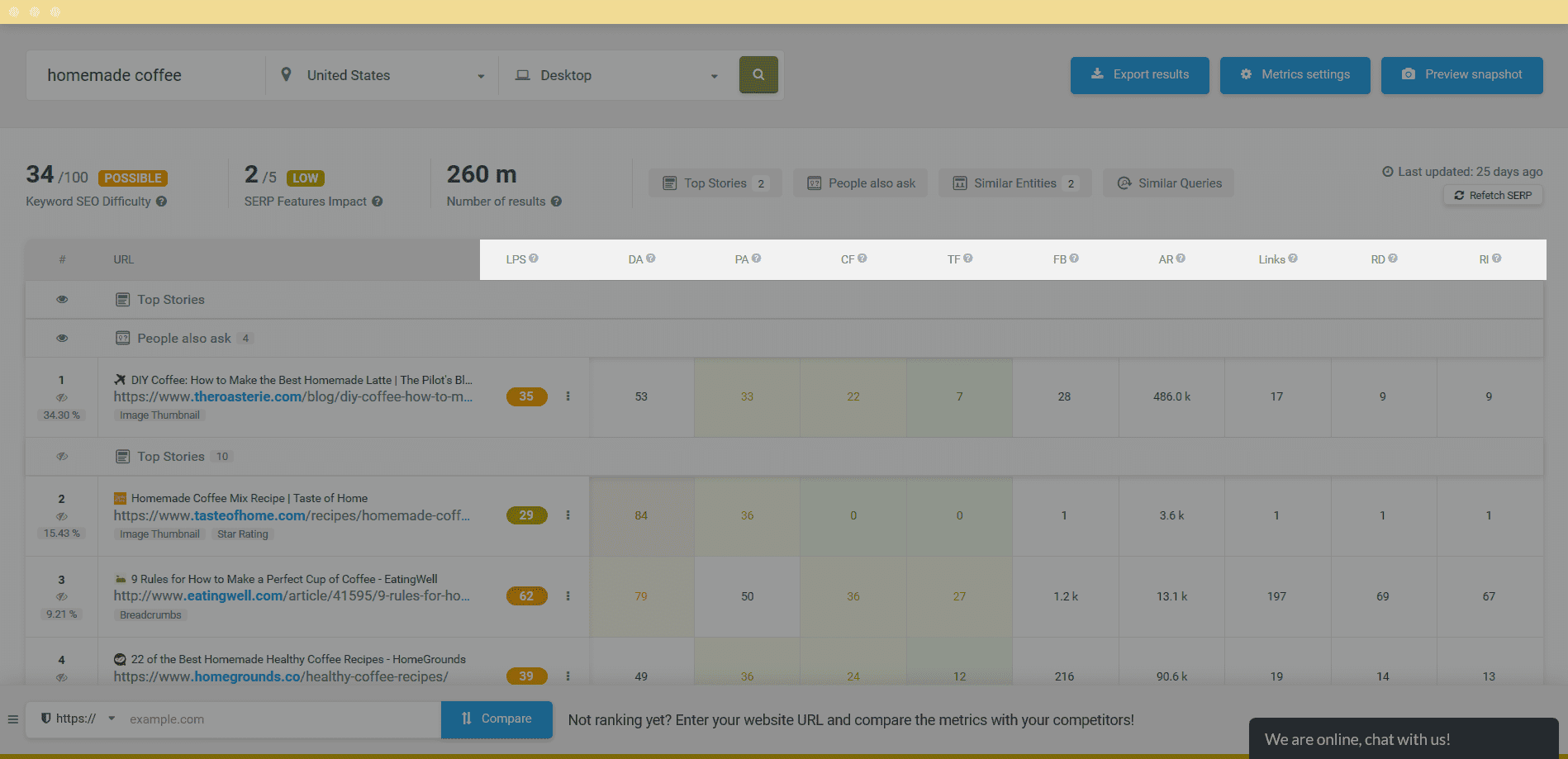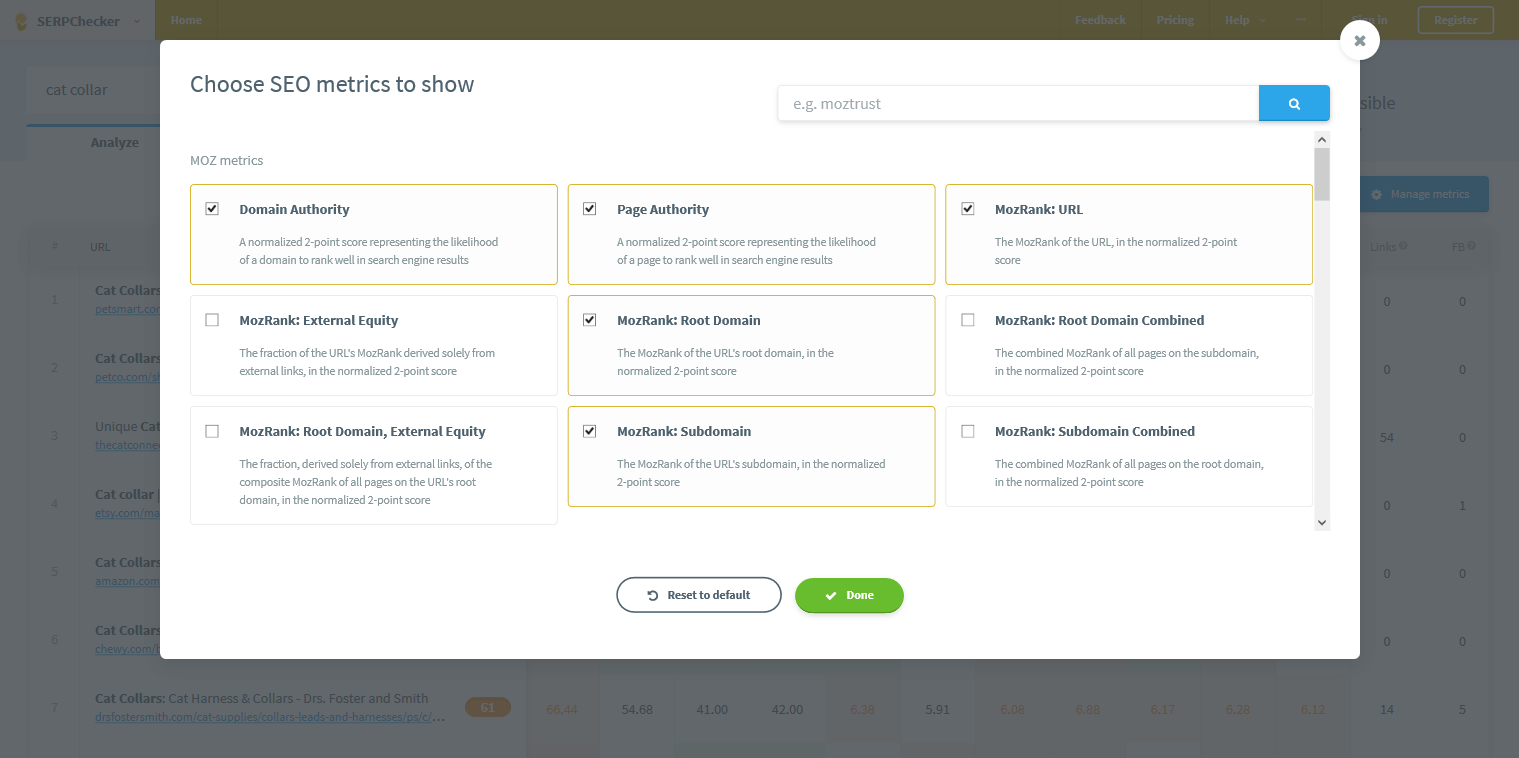Spy on competitors with more than 45 SEO and popularity metrics
Analyze the domain authority, backlink profile and popularity of URLs in the SERP.
1. Find out whether you are able to outrank your competitors
The goal of SERP analysis is to find out whether you picked the right keyword to optimize for. To do this, you need to evaluate the overall domain and page authority, backlink profile and popularity of URLs already ranking for the keyword in the 1st SERP.

The most widely used metrics to evaluate the URLs from the SEO point of view are the Domain Authority and Page Authority by Moz. They are in the default selection of the metrics which include:
- LPS - Link Profile Strength
- DA - Domain Authority
- PA - Page Authority
- CF - Citation Flow
- TF - Trust Flow
- FB - Facebook shares
- AR - Alexa Rank
- Links - External backlinks
- RD - Referring domains
- RI - Referring IPs
SERPChecker is not only a domain authority checker or backlink profiler. Metrics such as Alexa Rank and Facebook shares give you insights on the overall popularity of the URL in the SERP.
Quick tip:
The Link Profile Strength (LPS) is an aggregate metric developed by Mangools that helps you to evaluate how hard it is to rank on that particular position. Keep in mind that as other metrics, the LPS doesn’t take the relevancy into account. It means that a URL with score 20 can outrank another URL with score 60. To find out the estimated difficulty to rank for a keyword on the 1st SERP, check the Keyword Difficulty in KWFinder.
2. Work with SEO metrics of your choice
When you are analyzing the URLs, it’s good to use different metrics to get more points of view. Keep in mind that the metrics are often based on different data sources and many times, they are not to be taken as absolute values.
A typical example of relative metrics is Page Authority (PA) and Domain Authority (DA). They are based on backlinks indexed by Moz.
Another set of widely used metrics is Trust Flow (TF) and Citation Flow (CF). These two are developed by Majestic, therefore, they are based on a different backlink index.
Quick tip:
Don’t compare PA and DA against TF and CF. Not only they are based on different data but they have different meanings. To find out more, make sure to read our SEO metrics guide.
The goal here is to evaluate the overall authority of the URLs ranking in the SERP and since many SEOs use different metrics to do that, we implemented more than 45 SEO metrics by Moz, Majestic and popularity metrics such as Alexa Rank and Facebook shares.

And the best thing? You can manage them in your own way by selecting the ones you are interested in. Click on the “Manage metrics” in the upper-right corner of the app and tick the metrics that suit you best. We have included short definitions in case you are not sure which ones to pick. Once you confirm the selection, all your future searches will be shown with these metrics.
Quick tip:
Use the metrics as trending values, not as the only determiners of your ability to outrank URLs in the SERP. Despite they help a lot, they do not take into consideration a very important factor - relevancy.
Try SERPChecker now
Get local SERPs for more than 50k locations
3. Download the data for further analysis and reporting
As an SEO person, you probably optimize many blog posts, landing pages or product pages, so you analyze hundreds of keywords and SERPs. However, everything can’t be done in tools.
Sometimes you need custom reports and spreadsheets for your own needs or for the clients. Feel free to download the researched data anytime by clicking on the “Export results” button.
Try SERPChecker now
Get local SERPs for more than 50k locations
Explore all features of SERPChecker
- Google SERP Analysis Tool
- Scan Local Search Results for 50k Locations
- Spy on Competitors with 45+ SEO Metrics